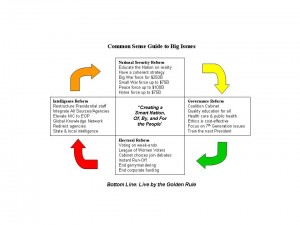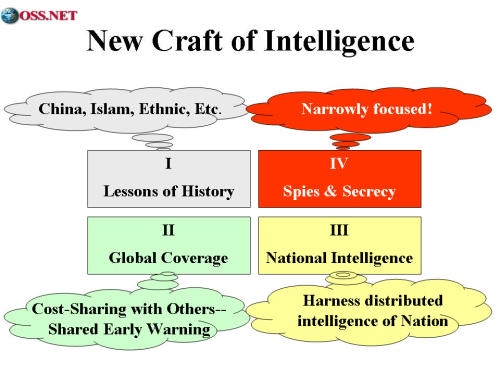
Graphic: Four National Reforms
Advanced Cyber/IO, Balance, Capabilities-Force Structure, Leadership-Integrity, Reform, Strategy-Holistic Coherence
See Also:
2008 Election 2008 Chapter: The Substance of Governance
2002 Robert Steele: Citizen in Search of Integrity (Full Text Online for Google Translate)
1995 GIQ 13/2 Creating a Smart Nation: Strategy, Policy, Intelligence, and Information
1992 E3i: Ethics, Ecology, Evolution, & intelligence (An Alternative Paradigm)
Graphic: OSINT Support to Four Levels of Analysis
Advanced Cyber/IO, Analysis, Balance, Innovation, Leadership-Integrity, Multinational Plus, Reform, Strategy-Holistic Coherence
This is the slide that grabbed General Peter Schoomaker, USA (Ret), the ONLY Army flag officer that has ever understood OSINT in detail. General Schoomaker's intelligence and integrity are the sole reason the U.S. Government has today exactly ONE serious OSINT capability as represented by J-23 at the U.S. Special Operations Command (USSOCOM). Everything else is fluff, lip service, and broken promises.
Reference: Multiscale Networks for Global Environmental Governance
Advanced Cyber/IO, Articles & Chapters, Cultural IntelligenceSummary: The rigid hierarchy that characterizes state bureaucracies has also been embedded into internaitonal institutions, and it is this architecture that can be vastly improved by restructuring it into a multiscale network. There are both descriptive and prescriptive reasons for doing so: 1) increases in functional efficiency and robustness, and 2) improvements from a normative perspective. As we enter the 21st century, the international system already exhibits many aspects of multiscale networks, but there are typically seen as liabilities and not assets. By providing a richer understanding of multiscale networks, this paper proposes an alternative to Cox's “with them or against them” ultimatum.
Reference: Panarchy–Governance in the Network Age
Advanced Cyber/IO, Articles & Chapters, Cultural IntelligenceABSTRACT: The primary hyposthesis that I will endeavor to support is that leveraging the benefits of network organization constitutes a new source of power and a new way of accomplishing global governance.
Complexity + Networks + Connectivity = Panarchy
CONCLUSION: In this paper I have shown that the convergence of processes crosses a critical threshhold to create new possibilities for governance. The result is a new system. The key distinction between the old system and the new lies in the fact that governance in the old system was achieved through states, whereas in the new system it is not only achieved outside of hierarchies through horizontal networks, but is in fact often achieved in spite of hierarchies.
Phi Beta Iota: The author is meticulous in crediting James N. Rosenau, Turbulence in World Politics: A Theory of Change and Continuity (Princeton, NJ: Princeton University Press, 1990) for originating many of the concepts that underlay the emergent scholarship on panarchy.



